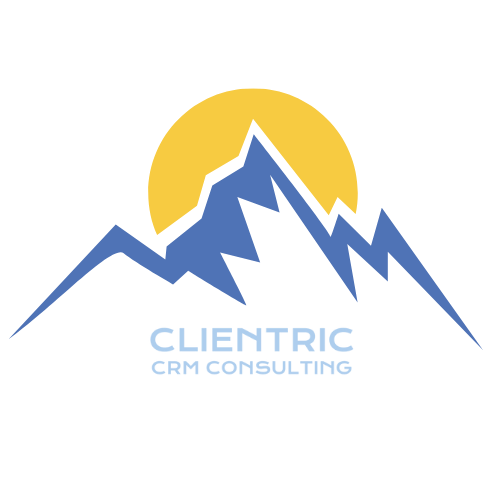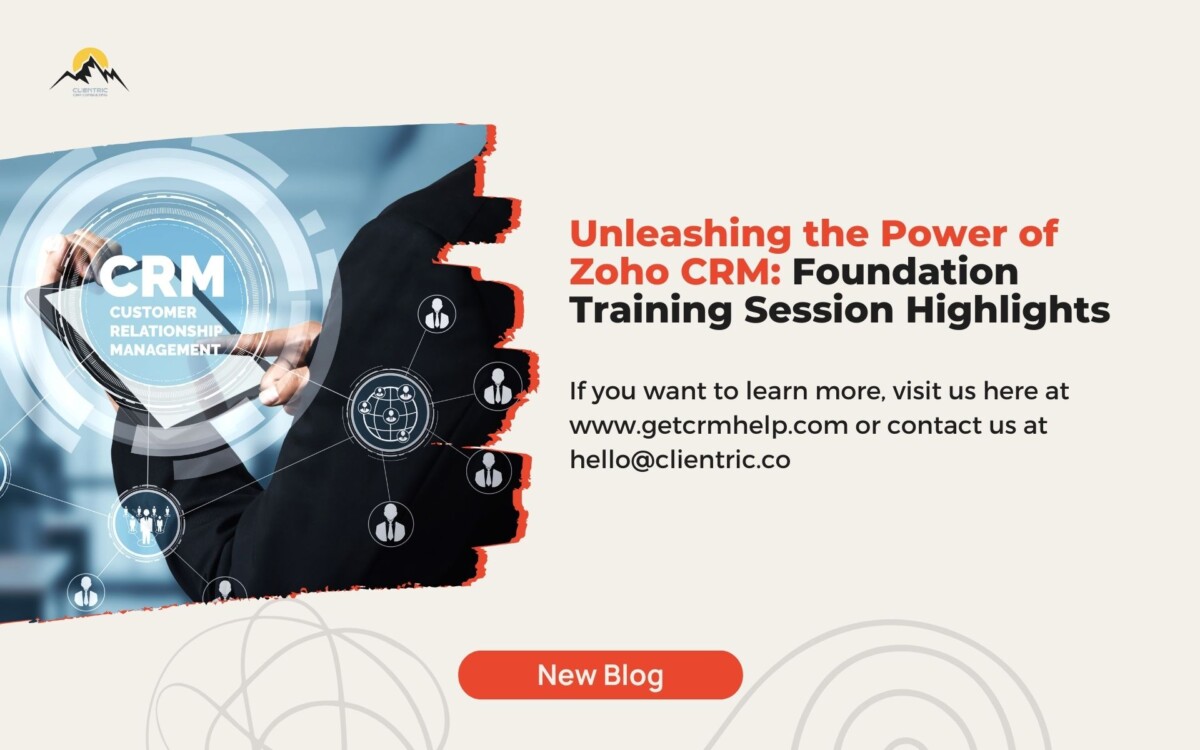Greetings, CRM enthusiasts! We are thrilled to share the highlights of our recent Zoho CRM Foundation Training session conducted by one of our Clientric’s team member Sanjana. In this comprehensive training, Sanjana covered fundamental aspects of Zoho CRM, addressing specific topics requested by her colleagues. Let’s delve into the key takeaways!
1. A Walkthrough of Zoho CRM Basics:
Sanjana kicked off the session with a basic overview of Zoho CRM, catering to the request from Paige. She demonstrated how new users can set up their CRM accounts, navigate the platform, and customize their CRM experience. The walkthrough included insights into the home page, default views, and the classic view.
– Dashboard Customization:
Our team member Paige inquired about integrating a calendar view into the dashboard. Sanjana showcased how users can personalize their home pages by adding components, creating custom views, and even integrating third-party applications as widgets.
2. Reports and Dashboards Deep Dive:
Next on the agenda was an in-depth discussion on reports and dashboards, addressing our team member Katelyn’s questions on the topic. Sanjana explained the intricacies of designing effective dashboards, demonstrating how to configure various components and gain insights into data.
– Calendar Widget Integration:
Paige raised a question about integrating a calendar widget. Sanjana provided insights into the challenges and potential solutions, emphasizing the importance of dynamic data.
3. Workflows and Zoho Analytics:
Scott’s request led to a detailed exploration of workflows and Zoho Analytics. Sanjana covered how users can leverage workflow rules to automate processes within Zoho CRM. Additionally, she shed light on the integration of Zoho Analytics for enhanced data analysis.
4. Leads, Contacts, Accounts, and Deals:
Sanjana delved into the essential concepts of Leads, shedding light on their significance as raw data or potential clients. Leads serve as the initial stage in connecting with prospects. She explained that you can gather data from various sources, like your website or conference lists, and input it as leads in Zoho CRM. The platform allows you to follow up with leads using activities such as creating tasks, scheduling meetings, or making calls.
– Conversion Process:
Sanjana outlined the conversion process, emphasizing that when a lead shows interest, you can convert it into a contact. Simultaneously, the associated company becomes an account. Furthermore, if you propose a deal, the Deals module comes into play.
5. Additional Modules: Tasks, Meetings, Calls, and Feeds:
Here we highlighted the importance of modules like Tasks, Meetings, and Calls, where all corresponding activities are stored. Tasks may include follow-ups or important to-dos, meetings are scheduled for detailed discussions, and calls are logged for reference.
– Feeds Module:
An intriguing module discussed was Feeds, acting as an internal communication platform within CRM. It facilitates discussions, sharing thoughts, and tagging users, promoting collaboration. Moreover, it serves as a log for tracking changes made to records across modules.
6. Calendar View:
We also covered the Calendar View, allowing users to visualize scheduled tasks, events, and calls for the day, week, or month. Users can mark themselves as unavailable, providing transparency to others when scheduling meetings or calls.
7. Setup Module: Customizing Your CRM Experience:
We proceeded to unravel the Setup module, a pivotal area for customizing various aspects of the CRM account. By clicking on the settings icon, users are redirected to the setup page, providing a comprehensive array of customization options.
– Personal Settings:
Within personal settings, users can tailor their CRM experience by adjusting personal information, language preferences, date formats, and time formats. The platform supports multiple languages, enabling users to choose their preferred language.
– User Management:
The setup module facilitates user management. Users can add team members by purchasing user licenses. Before delving into user-related information, Sanjana introduced two critical features—Profiles and Roles—that govern user access.
8. Profiles and Roles: Fine-Tuning User Permissions:
– Profiles:
Profiles play a crucial role in determining user permissions for data access. They grant or restrict users’ ability to perform operations within specific modules. For instance, a profile can be configured to allow viewing leads data while restricting the creation or editing of leads. This meticulous control ensures tailored access for each user.
– Roles:
Roles complement profiles by regulating access to data within modules. The setup allows for two hierarchical structures—role hierarchy and reporting hierarchy. In the hierarchy of roles, superior roles have access to data owned by subordinate roles. For example, a Sales Manager may have access to data owned by sales executives reporting to them. The reporting hierarchy designates a single reporting person who can view the data assigned to others. This creates a streamlined reporting structure within the CRM.
9. Reporting Hierarchy and Role Hierarchy: Structuring Access Control:
– Role Hierarchy:
We illustrated role hierarchy by using an organizational scenario where a CEO oversees Sales Managers, who, in turn, manage Sales Executives. This hierarchy allows users at higher levels to access data owned by users in subordinate roles.
– Reporting Hierarchy:
Reporting hierarchy introduces a different dynamic. A user, like a manager, is assigned as the reporting person to another user. This setup enables the reporting person to view the data assigned to the user they are reporting for. In essence, it streamlines data visibility based on reporting relationships.
10. Data Sharing Settings and Channels: Enhancing Access Control and Communication:
We delved into additional features within the Setup module, shedding light on Data Sharing Settings and Channels. While the role hierarchy inherently governs data access for superior and subordinate users, there are scenarios where specific data needs to be shared with users outside this hierarchy.
– Data Sharing Settings:
Data Sharing Settings offer a solution by enabling the creation of sharing rules. These rules define criteria for sharing data with users in specified roles. By setting criteria, you can precisely determine which records will be shared, ensuring a flexible and controlled data-sharing environment.
– Channels:
The Channels section facilitates integration with diverse communication platforms. Users can seamlessly incorporate email services, telephony for call management, and even create web forms directly within CRM. Integration with social media platforms like Facebook and Twitter allows users to track and manage interactions from these channels directly in CRM.
11. Customization: Tailoring CRM to Your Business Needs:
We explored the heart of customization within Zoho CRM—the ability to adapt the system to specific business requirements. Under the ‘Customization’ section in Setup, users can:
– Modify existing modules by adding or removing fields according to their needs.
– Create entirely new modules to accommodate unique sets of data not covered by default modules like leads or contacts.
This flexibility empowers businesses to mold Zoho CRM to align seamlessly with their operational processes.
12. Reports: Harnessing Data Insights:
The Reports feature in Zoho CRM provides a robust tool for gaining insights into your data. Users can create reports that present information in a tabular format, allowing for a comprehensive view of related data.
– Creating Reports:
Users can initiate report creation by selecting a base module, such as leads. Columns and row groups can be customized to display specific fields and group data based on certain criteria. For instance, grouping leads by lead source.
This advanced reporting functionality facilitates in-depth analysis and empowers users to make informed decisions based on comprehensive data sets.
13. Creating Comprehensive Reports:
The process of creating insightful reports continued as Sanjana showcased additional features within Zoho CRM’s reporting capabilities. After demonstrating basic report creation, she explored more advanced options:
– Column Groups:
Users can group report data by specific columns, enhancing the granularity of information. As we demonstrated this by grouping leads based on their lead source and city, providing a nuanced view of data.
– Aggregate Columns:
Aggregate columns empower users to display summarized data. Sanjana illustrated this by showcasing how to present data like the count of leads or the average of annual revenue within a report.
– Join Reports:
For a holistic view, Zoho CRM allows the joining of multiple reports. Sanjana created a second report, focusing on leads grouped by industry. By utilizing the ‘Join Reports’ feature, she seamlessly integrated data from both reports into a unified view.
14. Analyzing Data with Dashboards:
Sanjana then transitioned to Zoho CRM’s Analytics module, commonly known as Dashboards. While reports offer a tabular representation of data, dashboards provide a more visual, pictorial representation. Key components of the dashboards include:
– Charts:
Users can create visual representations of data using various chart types, such as column charts, bar charts, and pie charts. These charts can be configured based on specific criteria, offering a clear and concise visual overview of CRM data.
– KPIs (Key Performance Indicators):
KPIs provide a snapshot of essential metrics. Users can set up KPIs to track changes and growth indices, create ranking boards, or evaluate key performance indicators for different modules.
By combining reports and dashboards, businesses gain a comprehensive understanding of their CRM data, enabling informed decision-making and strategic planning.
15. Crafting a Scorecard for Top Performers:
Sanjana demonstrated the creation of a scorecard within the KPI component. This feature allows businesses to rank top performers within the organization based on specific criteria. In the example provided, leads were ranked by industry, offering a quick and visual assessment of performance.
As businesses navigate the complexities of CRM data, the powerful reporting and analytics features in Zoho CRM emerge as invaluable tools for unlocking actionable insights.
16. Maximizing Business Insight with Comparator:
Continuing the exploration of Zoho CRM’s Analytics module, Sanjana introduced the Comparator component. This versatile tool enables users to compare data dynamically, fostering a deeper understanding of CRM metrics. She illustrated how businesses can leverage the Comparator to analyze and contrast data among users or across different time periods and picklist values.
– User Comparison:
Sanjana showcased a user-centric comparison, selecting a field (stage) within the Deals module. The Comparator was then configured to display this week’s count of deals with a closing date compared to the previous week. The resulting chart effectively highlighted positive changes and offered a quick visual analysis of performance.
17. Identifying Anomalies with Zia’s Anomaly Detective:
Zia, the AI-powered assistant in Zoho CRM, plays a pivotal role in detecting anomalies within data patterns. Sanjana demonstrated how users can employ Zia’s Anomaly Detective to identify significant changes in a constantly evolving dataset. By setting parameters such as frequency (weekly or monthly), businesses can receive proactive alerts about any unusual variations in their CRM data.
– Configuring Anomaly Detection:
Sanjana walked through the process of setting up anomaly detection for the Deals module. This involved defining specific date fields, frequency preferences, and performance metrics. The Anomaly Detective feature, driven by Zia’s analytical capabilities, promises to be a valuable asset in flagging unexpected shifts in CRM data.
18. Setting Targets and Monitoring Progress:
Setting and monitoring targets is integral to assessing performance and driving organizational goals. In this segment, Sanjana elucidated how Zoho CRM’s Analytics module facilitates the creation of target meters and region-wise targets.
– Individual Target Meters:
Users can set individual targets for specific users or entities within Zoho CRM. Sanjana demonstrated the creation of a target meter, choosing lead source as the picklist values and assigning distinct targets to each. The resulting target meter offered a visual representation of progress towards achieving set targets.
– Region-Wise Targets:
For scenarios involving multiple users or regions, Zoho CRM allows the setting of region-wise targets. By selecting users and associating targets with picklist values, businesses can gain a comprehensive overview of each entity’s performance and contribution towards shared objectives.
19. Streamlining Data Analysis with Funnel Charts:
To cap off the analytics showcase, we got an introduction to Funnel Charts within Zoho CRM’s Analytics module. This dynamic visualization tool aids in tracking and understanding the progression of leads through various stages.
– Creating a Funnel Chart:
Sanjana demonstrated the creation of a Funnel Chart using the leads module. By focusing on the leads created and subsequently identifying converted leads, the Funnel Chart showcased the conversion process. This style of chart is particularly useful for evaluating the effectiveness of lead management strategies.
As Zoho CRM users delve into these advanced analytics features, they gain the power to unlock deeper insights, optimize workflows, and elevate decision-making. The synergy of reports, dashboards, and dynamic analytics components propels businesses toward data-driven success.
20. Tailoring Dashboards to Client Preferences:
Following the exploration of advanced analytics components, Destiny raised a crucial point about tailoring reports and dashboards to client preferences. As we acknowledge the significance of understanding client needs and preferences when building out reports. She proposed the idea of breaking down available options for clients, showcasing the variety of reports and how data can be visually represented in analytics.
21. Transitioning from Reports to Analytics:
Sanjana reiterated that while reports provide a tabular representation of data, analytics and dashboards offer a more dynamic and visual way to interpret and understand information. She emphasized the importance of guiding clients through the transition from standard reports to analytics, demonstrating how to convert reports into charts for better data visualization.
22. Addressing Overwhelm with Guidance:
Paige expressed a sense of overwhelm, and Sanjana empathetically acknowledged the extensive options available within Zoho CRM’s analytics features. She suggested breaking down the information into digestible chunks and, potentially, creating tutorial content like a Loom video to guide users through the available reports and analytics components.
23. Integrating Analytics Components into Dashboards:
Katelyn inquired about the placement of analytics components, specifically whether they can be added to the main dashboard or if they are confined to the Analytics module. Sanjana provided a quick demonstration of how analytics components can be seamlessly integrated into dashboards. Users can select their preferred dashboard and add various charts and reports for a comprehensive overview.
24. Simplifying Dashboard Integration:
Sanjana showcased the simplicity of adding components to dashboards directly from the home page. By clicking on the three dots, selecting “Add component,” and choosing the desired dashboard, users can effortlessly incorporate analytics components into their main workspace.
The session concluded with Katelyn expressing gratitude for the clarity provided, making the integration of analytics components into dashboards appear user-friendly.
25. Streamlining Data Automation:
Sanjana addressed the query about incorporating analytics components into dashboards on the homepage. She highlighted the flexibility of dashboards, expressing that having graphical representations directly on the homepage is beneficial for users who prefer visual insights. Sanjana emphasized that while reports can’t be added directly to the homepage, dashboards provide a dynamic and visually appealing solution.
26. Simplifying User Experience:
Sanjana reinforced the idea that dashboards offer a user-friendly way to view and analyze data. The ease of adding components to dashboards, as demonstrated, allows users to curate a personalized homepage with key analytics components for quick reference.
27. Workflow Rule Overview:
Destiny initiated a discussion on the workflow rules module, seeking to explore automation possibilities within Zoho CRM. Sanjana explained that workflow rules enable users to automate various actions based on specific conditions. These actions range from sending emails and creating records to assigning tasks and updating fields.
28. Triggering Workflow Actions:
Sanjana demonstrated how workflow rules can be triggered based on record actions (creation, editing, or deletion), date or time fields, record score, notes, and more. She showcased the diverse conditions and triggers available, illustrating the flexibility of workflow rules in responding to different scenarios.
29. Email Notifications and Scheduled Actions:
To provide a practical example, Sanjana detailed how a workflow rule could send an email notification when a lead with a specific source, such as “advertisement,” is created. Additionally, she introduced the concept of scheduled actions, allowing users to automate tasks after a designated time period following record creation.
30. Scheduled Actions for Continuous Automation:
Sanjana showcased the power of scheduled actions, which enable users to set up recurring actions. This feature is particularly useful for scenarios like sending monthly emails or updating specific fields at regular intervals.
31. Multiple Conditions for Precise Automation:
Addressing the need for more complex conditions, Sanjana explained how users can add multiple conditions to workflow rules. She demonstrated the creation of a workflow rule with dual conditions, illustrating how the automation engine processes conditions sequentially, triggering actions based on the first matched criterion.
32. In-Depth Workflow Rule Configuration:
Sanjana dove deeper into workflow rule configurations, exploring options like field updates, assigning records, adding tags, sending email notifications, creating tasks, and converting records. The versatility of workflow rules allows users to define specific actions based on intricate conditions.
33. Custom Functions and Web Hooks:
Sanjana briefly touched upon advanced features such as custom functions and web hooks, showcasing the extensibility of workflow rules for users with more complex automation requirements.
34. Real-Time Demonstration:
Concluding the session, Sanjana performed a live demonstration of a workflow rule triggering email notifications and scheduled actions based on specific lead creation conditions.
35. Future Topics and Support:
Sanjana opened the floor for questions, clarifications, or any specific topics attendees would like to explore in future sessions. She expressed her readiness to assist with any concerns or provide further guidance on CRM functionalities.
The session concluded with thanks from the attendees, who appreciated the comprehensive insights shared by Sanjana. The promise to share a recording of the session was made, ensuring valuable information could be revisited.
Stay tuned for more sessions, tutorials, and expert insights from Clientric CRM Consulting as they continue their exploration of Zoho CRM’s features. If you have specific questions or topics you’d like covered, don’t hesitate to reach out here in the comment section.
Happy automating with Zoho CRM!



